
Football is a sport that is evolving continuously. The football that we see today was not the same as the football legends like Maradona, Yashin, Garrincha or Cryuff played in the 20th century.
Even the football played in the last few years won't be the same as the one played in the next few years. New rules are made, outdated ones are scrapped, new tactics emerge and old ones are left unused. That is how football as a sport grows.
It brings out new ideas and new revolutions that make the game even more beautiful than it already is. On that note, let us see one such rule change and the nuances it has already introduced.
The Old Goal Kick Rule:
The International Football Association Board (IFAB) is the body that determines the laws of football in association with FIFA. According to its website, the old goal kick procedure was:
- The ball must be stationary and is kicked from any point within the goal area by a player of the defending team.
- The ball is in play when it leaves the penalty area.
- Opponents must be outside the penalty area until the ball is in play
This effectively means when the goalkeeper is taking a goal kick, be it short or long, no player can be inside the penalty box.
One important aspect to notice here is that even the players of his own team cannot be inside the area to receive a pass. Why? Because the second point in the rule states that the ball is in play only when it leaves the penalty area. That means if a teammate is inside the area, the pass from the goalkeeper to that player is not legal.
Well, he or she could stay inside the area and move out while receiving the pass but that would be useless. So, the central defenders usually positioned themselves on either side of the goalkeeper outside the penalty box to receive the first pass.
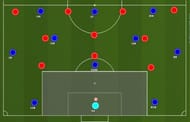
In Figure 1, the blue icons represent the team building-up from the back, while the red icons represent the pressing team. The goalkeeper of the build-up team is in light blue. You can see the centre-backs of the blue team dropping back on either side of the penalty area.
The main aim of the pressing team is to win the ball back as high up the field as possible. To counter this, the centre-backs drop back while the full-backs move higher and wide, hugging the touchline. The midfielders and the forwards of the build-up team spread themselves out on the pitch.
This is done to create as much space as possible between the players that would open up the field and make the opponent press, making it easier to play the ball in space to counter the press.
But everything is not so fine and dandy for the team trying to build-up from the back. The situation is complicated as the opponent forwards can press aggressively as soon as the ball is released by the goalkeeper. The outfield players not being to enter the penalty box means the build-up team cannot use a huge area in the field to play the ball in, and that effectively allows the pressing team to control less area while pressing aggressively.
It is not a good thing for the build-up team as they need as much space as possible to counter the press. Additionally, when the centre-backs position themselves outside the penalty area on either side of the goalkeeper (Figure 1) the full-backs station themselves further up the pitch as they cannot drop deep and occupy the same space as the centre-backs.
In such an instance, there is the risk of the passing lane towards the full-back being cut off by the pressing opponent forwards, thereby depriving the support offered by the full-back. This makes it difficult for the team building-up from the back to get the ball out of their final third, thereby handing an unfair advantage to the team pressing during the goal kick.
Unless the build-up team has ball-playing centre-backs, the goalkeeper will be forced to go for long goal kicks that might result in loss of possession. Even in the case of ball-playing centre-backs, there remains a great risk that the possession might be lost as soon as they receive it.
The New Goal Kick Rule:
The goal kick rule has now been changed by the IFAB. The new goal kick procedure is as follows:
- The ball must be stationary and is kicked from any point within the goal area by a player of the defending team
- The ball is in play when it
leaves the penalty areais kicked and clearly moves - Opponents must be outside the penalty area until the ball is in play
Only a few words have been changed but it has an enormous impact on the way football would be played. As you can see, the ball is in play immediately after it is kicked. This results in two key changes in the game: The outfield players of the build-up team can be inside the penalty area or even take the goal kick and the pressing team players can enter the penalty area as soon as the ball moves and it need not leave the penalty area.
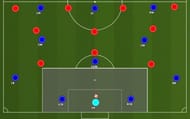
How does the goal kick rule change help the build-up team?
The tweak in the goal kick rule means that the entire half of the field is now open to play. The pressing team players need to press from the half-way line to the opposition goal line. This rule change has also provided more space for the build-up team to play the ball in, and the goalkeeper gets safe short passing options as well as long passing options. The centre-backs can now position themselves inside the penalty area and the full-backs can drop deeper (Figure 2) to provide the numerical overload to counter the first line of press.
But the full-backs need not necessarily drop deep. For instance, they can still be high up the pitch (Figure 3) while the centre-backs and the defensive midfielder drop deep to receive the ball. By absorbing the opponent pressure while opening up the pitch further forward, the full-backs can venture upfield after receiving the ball and provide the numerical overload in the second third of the pitch.
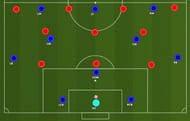
Variations used by the build-up team to beat the press and move forward:
We will see some specific variations that can be used by the team building up from the back to counter the press as they move forward with the ball.
The main aim of these variations is that the build-up team must be able to beat the first line of the press as quickly and easily as possible and move forward with the ball.
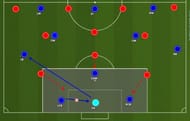
In these variations, one of the centre-backs of the build-up team takes the goal kick. A centre-back taking goal kick was unheard of before but not anymore.
Teams have already started tweaking their goal kick strategy to take advantage of the rule change. The first team to implement this has been none other than FC Barcelona who have been at the forefront of goalkeeping revolution in the past few decades. They used this tactic in a La Liga match against Getafe to counter the opponents' aggressive pressing. You can read this in detail in the last part of this article.
In the first variation, the centre-back taking the goal kick passes the ball to the goalkeeper. Now that the ball has started moving, it is in play and the opponent players can enter the box to press.
Predictably, one of the forwards moves towards the ball. That is the opponent forward who moves to press the keeper. His movement is such that the goalkeeper will not have the option of returning the ball back to the centre-back.
At the same time, the other two opponent forwards press the defensive midfielder and the other centre-back of the build-up team. As the opponent team players can't be inside the box before the ball is in play, they have to cover a certain amount of distance to win the ball. This takes time which is utilised by the goalkeeper to execute a vaulted pass to his team's full-backs (Figure 4).
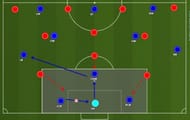
Or the goalkeeper can take a slightly riskier approach and pass the ball to his team's defensive midfielder who is facing the goalkeeper and is also under pressure. The midfielder then deflects the ball towards the free full-back. The full-back, upon receiving the ball, can move forward to create numerical overload further up the pitch. That would tilt the advantage towards the build-up team easily and also help them beat the first line of press.
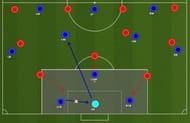
The second variation is used when the full-backs of the build-up team are marked closely. This eaves one of the central midfielders free from opponent pressure. This midfielder positions himself in the empty space and can receive a long ground pass or a vaulted one from the goalkeeper beating the first line of press.
It is crucial to note that in both scenarios mentioned above (free full-backs and full-backs under pressure), the opponent team maintains the shape of its backline. If the pressing team chooses to press the build-up team's full-backs with their own full-backs, then that situation presents its own risks to the pressing team.
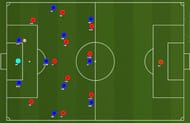
As you can see in Figure 7, this situation leads to a 3-vs-3 situation in the front. This is where the danger lies as the goalkeeper can use the situation to make a long ball to his team's forwards who cannot be offside during a goal kick.
Or the build-up team's centre-backs and goalkeeper can use one of the above-mentioned variations to beat the press. They can then move the ball to their teammates occupying positions further up the pitch who can quickly make a through ball to the forwards, splitting the opponent defensive line.
As the forwards are situated in their own half, they cannot be offside when receiving the ball. With skill and proper coordination, they can create an easy scoring opportunity. This, however, would greatly depend on the coordination and proper team movement by the build-up team to take advantage of the goal kick rule change and get the ball to the forwards as quickly as possible.
There is an added advantage in this regard: using these long balls or through balls to forwards often can make the pressing team withdraw towards their own goal, which will relieve the pressure on the build-up team.
The primary aim of this article is to emphasise the fact that the few seconds it takes the pressing forwards to move closer to the ball inside the penalty area gives a vital edge to the build-up team to break the first line of press.
This was not possible before because each and every outfield player of the build-up team would have been pressed in such a way that there were no safe passing options for the goalkeeper. Or the centre-back receiving the ball from the goalkeeper had to move from the back, which would have made it difficult to hold the ball after a goal kick.
Now that the pressing team is unable to enter the penalty area, the first pass can be made safely. it also opens up space or frees up a teammate who can take the ball forward. So, basically, with this goal kick rule change, you have the same constraints on the pressing team while removing them for the build-up team, giving them those few crucial seconds to make the safe first pass that makes all the difference in the world.
